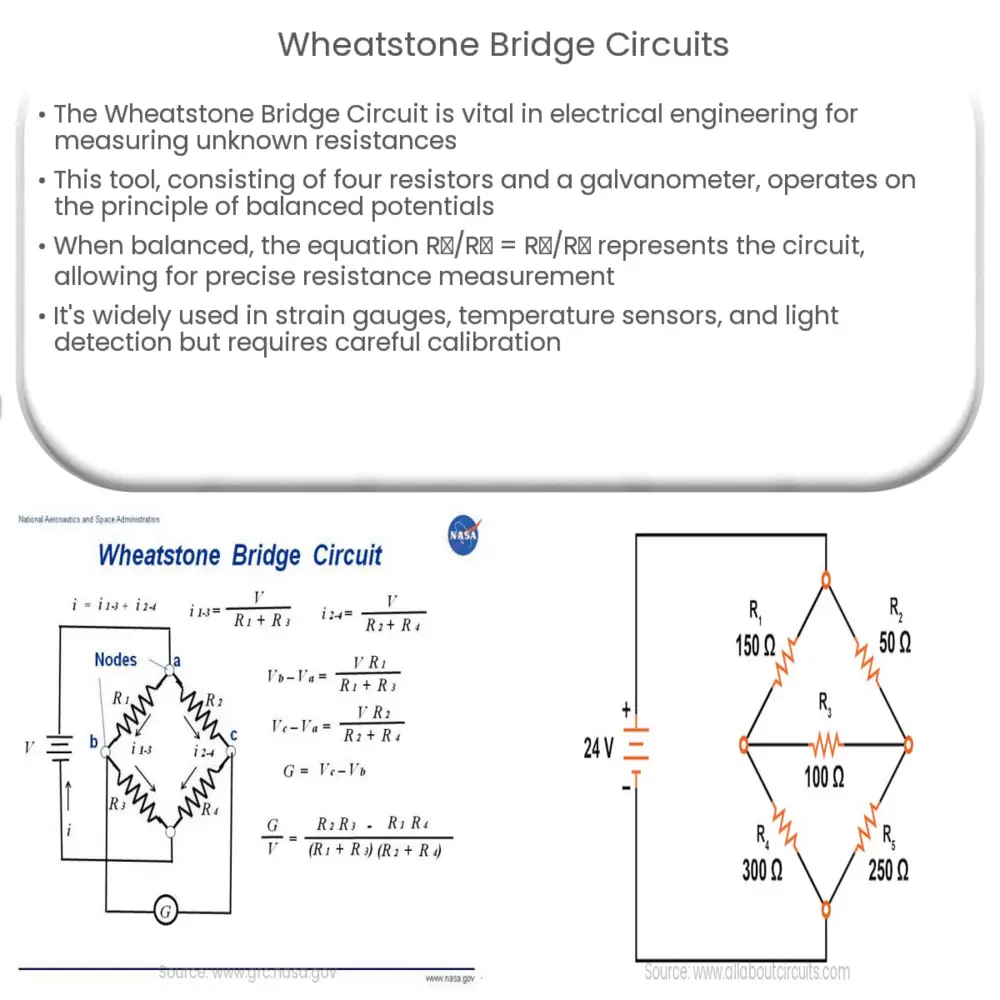Explore the Wheatstone Bridge Circuit’s structure, operation, applications, advantages, and limitations in our comprehensive guide.

Understanding the Wheatstone Bridge Circuit
The Wheatstone Bridge Circuit is a crucial concept in the realm of electrical engineering and physics. Named after Sir Charles Wheatstone, the British scientist who popularized it, this circuit configuration serves as a powerful tool in measuring unknown electrical resistances.
Consisting of a simple arrangement of resistors, the Wheatstone bridge is predominantly employed in the detection of small changes in resistance. This is particularly advantageous when it comes to precision measurement devices like strain gauges or thermistors.
Basic Structure of the Wheatstone Bridge
The Wheatstone Bridge circuit is elegantly simple. It is essentially a quadrilateral comprising four resistors with a power source connected across its diagonal. Another key element in the Wheatstone Bridge is the galvanometer, which is placed along the other diagonal of the quadrilateral. This instrument is used to measure the current flowing through the circuit, serving as an indicator of whether the bridge is balanced or not.
- The four resistors are denoted as R1, R2, R3, and Rx.
- Rx is an unknown resistance that is to be measured.
- The galvanometer connected between points B and D detects any current flow between these points.
Operation of the Wheatstone Bridge
The principle of operation of the Wheatstone Bridge is based on the idea of balanced potentials. In a balanced condition, the ratio of resistances R1 to R2 is equal to the ratio of resistances R3 to Rx. Hence, in a balanced state, the potential difference across the bridge (B and D) is zero, indicating no current flow through the galvanometer. This condition is illustrated by the equation: R1/R2 = R3/Rx.
When this condition is met, we can derive the value of the unknown resistance Rx based on the values of the known resistors. This attribute of the Wheatstone Bridge makes it a fundamental tool in the field of electrical resistance measurement.
Applications of Wheatstone Bridge Circuits
The Wheatstone Bridge has widespread applications in various fields due to its precision and accuracy in measuring unknown resistances.
- Strain Gauges: One of the most common applications of the Wheatstone Bridge is in the field of material stress analysis. Strain gauges, which measure the deformation or ‘strain’ in a material, often use the Wheatstone Bridge circuit. A change in strain modifies the resistance of the strain gauge, which is then detected and measured by the Wheatstone Bridge.
- Temperature Sensors: Wheatstone Bridge circuits are also used in temperature sensors, such as Resistance Temperature Detectors (RTDs) and thermistors. These devices work by converting a change in resistance (due to temperature fluctuations) into a measurable voltage difference.
- Light Detection: Light-dependent resistors (LDRs) utilize Wheatstone Bridge circuits to measure variations in light intensity. As the amount of light hitting the LDR changes, its resistance changes, and this is picked up by the Wheatstone Bridge circuit.
Advantages and Limitations
Despite its simplicity, the Wheatstone Bridge offers numerous advantages. It is known for its high accuracy and sensitivity in measuring unknown resistances and detecting minute changes in resistance. Moreover, it is simple to set up and operates effectively under a variety of conditions.
However, the Wheatstone Bridge also has its limitations. Accurate measurements require precise calibration and adjustments of the bridge circuit. Additionally, it’s important to note that the Wheatstone Bridge assumes that the bridge is in a state of equilibrium, which may not be the case in certain real-world applications.
Conclusion
In conclusion, the Wheatstone Bridge Circuit, with its unique capacity to measure unknown resistances accurately, plays an integral role in various technological and scientific fields. Its concept, dating back to the 19th century, continues to be a cornerstone in modern-day electronics. Despite certain limitations, its benefits significantly outweigh the drawbacks, making it an indispensable tool in electrical measurement. As we move further into the era of technological advancements, the Wheatstone Bridge continues to hold its relevance and prominence, underlining the timeless nature of its design and utility.

